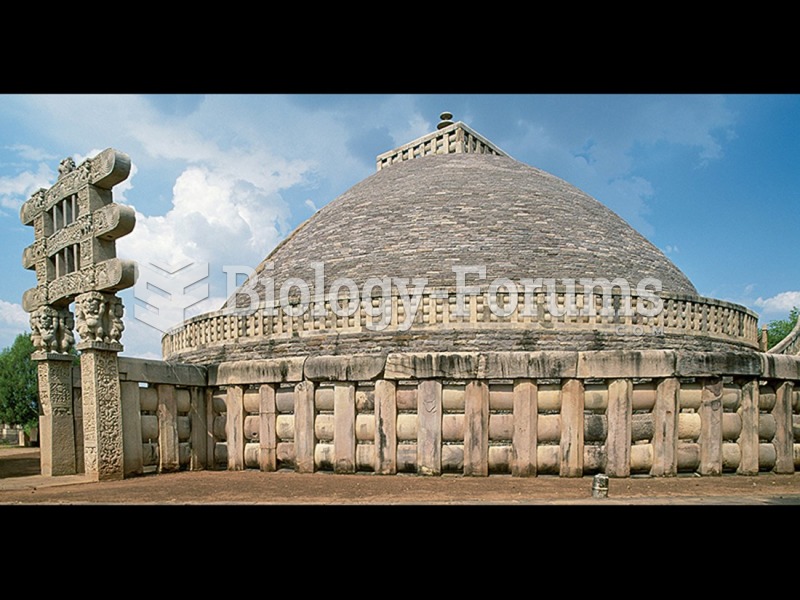Answer to Question 1
Buddhism, as it spread through India and China, was not unified and developed slowly. Stupas, burial mounds that contain the ashes of the Buddha, are beehive-like mounds of earth encased by brick or stone. Derived from the prehistoric burial mound, they symbolize at once the World Mountain, the Dome of Heaven, and the hallowed Womb of the Universe. A hemisphere set atop a square base, the stupa is also the three-dimensional realization of the cosmic mandalaa diagrammatic map of the universe used as a visual aid to meditation. As Buddhist pilgrims pass through the east gate and circle the stupa clockwise, tracing the path of the sun, they make the sacred journey that awakens the mind to the rhythms of the universe.
Buddhism's prohibition of idolatry influenced art in the first centuries after the Buddha's death, during which time artists avoided portraying the Buddha in human form. Like early Christians, Buddhists adopted a variety of symbols for the Buddha, such as the fig tree under which he meditated, his footprints, elephants, and, most important, the wheel (signifying both the sun and the Wheel of the Law). Unlike Christianity, however, Buddhism (like Hinduism) regarded sexuality and spirituality as variant forms of a single, fundamental cosmic force. Hence, Buddhist art did not condemn the representation of the nude body.
As Buddhism spread, the Chinese adopted the stupa as a temple-shrine and place of private worship, transforming its moundlike base and umbrella-like structure into a pagoda,or multitiered tower with many roofs. Musically, Buddhist chant in China and Japan was performed in the monasteries. It featured the intoning of statements and responses interrupted by the sounding of percussion instruments such as bells or drums. As the chant proceeded, the pace of recitation increased, causing an overlapping of voices and instruments that produced a hypnotic web of sound. Also adopted by Buddhists worshippers was the zither, one of China's oldest and most popular instruments.
Answer to Question 2
Between the fourth and sixth centuries, Christianity grew from a small, dynamic sect into a fully-fledged religion; and its ministerial agent, the Roman Catholic Church, came to replace the Roman Empire as the dominant authority in the West. The history of these developments sheds light on the formation of the Christian identity.
In the first centuries after the death of Jesus, there was little unity of belief and practice among those who called themselves Christians. But after the legalization of the faith in 313, the followers of Jesus moved toward resolving questions of church hierarchy, dogma (prescribed doctrine), and liturgy (rituals for public worship). From Rome, Church leaders in the West took the Latin language, the Roman legal system (which would become the basis for church or canon law),and Roman methods of architectural construction. The Church retained the Empire's administrative divisions, appointing archbishops to oversee the provinces, bishops in the dioceses, and priests in the parishes. As Roman emperors had held supreme authority over the state, so Roman Catholic popesthe temporal representatives of Christwould govern Western Christendom.
In the formulation of Christian dogma and liturgy, Latin scholars translated into Latin both the Hebrew Bible and the Greek books of the New Testament. This mammoth task resulted in the Vulgate, the Latin edition of Scripture that became the official Bible of the Roman Catholic Church. The Church leader Gregory the Great was vital to the development of early church government. Elected to the papacy in 590, Gregory established the administrative machinery by which all subsequent popes would govern the Church of Rome. However, the most profound and influential of all the Latin church fathers was Augustine of Hippo. His treatises on the nature of the soul, free will, and the meaning of evil made him the greatest philosopher of Christian antiquity.
Christian monasticism developed later, as the last remnants of Classical civilization disappeared. In 529, the same year that Plato's Academy closed its doors in Athens, the first Western monastic community was founded in southern Italy. Named after its founder, Benedict of Nursia, the Benedictine rule required that its members take vows of poverty (the renunciation of all material possessions), chastity (abstention from sexual activity), and obedience to the governing abbot. Benedictine monks followed a routine of work that freed them from dependence on the secular world, balanced by religious study and prayer.






